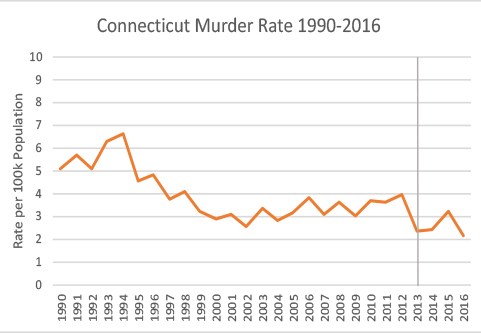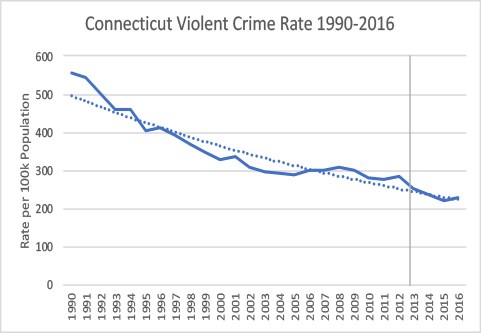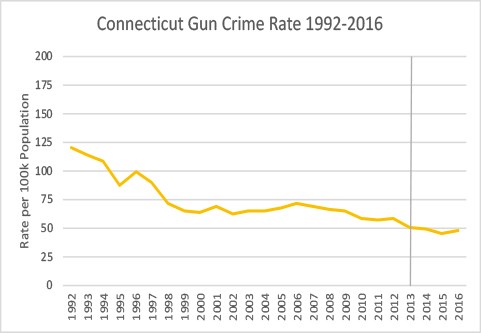Connecticut is often held up as a model of gun-control by gun control advocates and in-state legislators alike. The state enacted some of the most stringent gun control laws after the Sandy Hook tragedy. Specific measures included expanding the list of banned firearms, limiting magazine capacity, requiring registration of certain rifles and magazines previously –acquired, and expanding background checks.
WNPR reported that 2016 was the lowest homicide rate ever, according to state data. We examined this state data; 2016 was the lowest going back to at least 1990. What WNPR – and gun control advocates touting the 2013 Connecticut gun control laws – fail to mention is that the homicide rate increased each year from 2013 through 2015 before hitting the historic low in 2016. They also overlook that the homicide rate fell in 2010, 2011, and only increased in 2012 because of the monster who used stolen firearms to attack a school. The tragedy at Sandy Hook accounted for a 9.5% increase in the homicide rate from 2011 to 2012; outside of that single day, Connecticut would have seen an 11.5% decrease in the homicide rate.

It is reasonable to assume that the 2013 gun control laws were designed to impact all crime and not “just” homicides. Looking at the overall violent crime rate (which includes homicide, rape, aggravated assault, and robbery), there is a clear and pre-existing downward trend that started in the early 1990s. This is the same trend, by the way, that most of the country experienced over the same period.

Using data provided by the Connecticut Department of Public Safety, we calculated a gun crime rate. This figure represents the number of homicides, aggravated assaults, and robberies involving a firearm per 100,000 population. A downward trend began in the mid-2000s and continued through 2015 with a single exception: 2012. The Sandy Hook attack is not the only driver of the 2012 increase, but it did change the rate of increase between 2011-2012 from 0.3% to 1.6%.

Much like we saw with the Australian confiscation, a downward trend existed before the policy was changed. Attributing continued reductions to crime rates without regard for pre-existing trends is a favored device of the anti-gun researcher, but it shouldn’t be used to deceive Americans in such ways. Our analysis suggests that if you want to enact gun control, then you are free to advocate that position, but please also admit to the public that you are deceiving them when you claim that such restrictions actually have a positive impact on crime















 More Like This From Around The NRA
More Like This From Around The NRA








